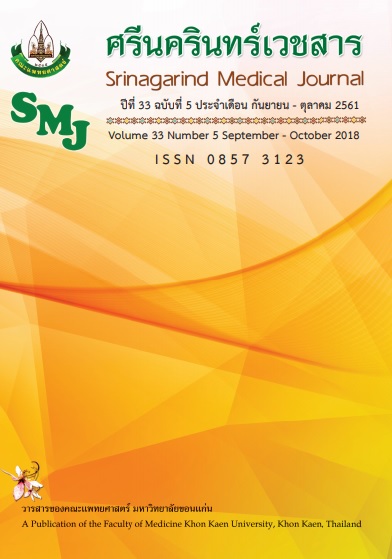Prevalence and Factors Associated with Musculoskeletal Disorders among Tea Farmers, Thoet Thai Subdistrict, Mae Fa Luang District, Chiang Rai Province
Keywords:
ระบบโครงร่าง; กล้ามเนื้อ; เกษตรกรAbstract
Background and Objective: Musculoskeletal disorders are more prevalent among farmers. The purpose of this study was to investigate the prevalence of musculoskeletal disorders and the relationship between ergonomic factors and musculoskeletal disorders.
Method: This study was the cross-sectional descriptive study. The 167 tea farmers, Ban Phaya Phrai Lao Ma, Ban Phaya Phrai Lao Cho, and Ban Phaya Phrai Li Thu, Thoet Thai subdistrict, Mae Fa Luang district, Chiang Rai province. The data were collected from the multi-stage random sampling during July to September 2015 by using questionnaires, 1) questionnaire about exposure to ergonomic factors and 2) musculoskeletal disorders with a modified Standardized Nordic Questionnaire and inferential statistical analysis was chi-square test to analyze the relationship between ergonomic factors and musculoskeletal disorders.
Results:The results of the study showed that prevalence of musculoskeletal disorders in the past 7 days and 12 months were 46.7% and 85.0%, respectively. In the past 7 days, the highest prevalence was the lower back (67.7%), followed by knee (42.5%) and shoulders (41.3%), respectively. In the past 12 months, the highest prevalence was the lower back (88.0%), followed by shoulders (61.7%) and neck (50.3%). Ergonomic factors found that inappropriate posture factor was 65.3% and repetitive working posture for more than 2 hours per day was 78.4%. The result of the statistical analysis was found the significant association (p<0.05) between ergonomic factors and musculoskeletal disorders in the past 12 months.
Conclusion: The findings indicate the important factors rerated to work-related musculoskeletal disorders were the problem among farmers who engaged in collecting tea leaves. Inappropriate posture factor and repetitive working posture for more than 2 hours per day should be considered to improve the working process and posture.
References
2. รุ้งทิพย์ พันธุเมธากุล, วัณทนา ศิริธราธิวัตร, ยอดชาย บุญประกอบ, วิชัย อึงพินิจพงศ์, มณเฑียร พันธุเมธากุล. ความชุกและภาวะความผิดปกติของระบบกระดูกและกล้ามเนื้อในชาวนา: กรณีศึกษาตำบลศิลา อำเภอเมือง จังหวัดขอนแก่น. วารสารเทคนิคการแพทย์และกายภาพบำบัด 2554; 23: 297-303.
3. อรวรรณ แซ่ตั๋น, จิราพร เขียวอยู่, ชุลี โจนส์, ดุษฎี อายุวัฒน์. ความผิดปกติทางระบบโครงร่างและกล้ามเนื้อในแรงงานก่อสร้างย้ายถิ่นชั่วคราวจากภาคตะวันออกเฉียงเหนือ.ศรีนครินทร์เวชสาร 2550; 22: 165-73.
4. สำนักความปลอดภัยแรงงาน กรมสวัสดิการและคุ้มครองแรงงาน กระทรวงแรงงาน. สถานการณ์การดำเนินงานด้านความปลอดภัยและอาชีวอนามัยของประเทศไทย ปี 2558. กรุงเทพฯ: บจก.พินนาเคิล แอดเวอร์ไทซิ่ง; 2558.
5. Bernard BP, editors. Musculoskeletal disorders and workplace factors: a critical review of epidemiologic evidence for work-relatedmusculoskeletal disorders of the neck, upper extremity, and low back. Cincinnati: National Institute for Occupational Safety and Health; 1997.
6. Davis KG, Kotowski SE. Understanding the ergonomic risk for musculoskeletal disorders in the United States agricultural sector. Am J Ind Med 2007;50:501-11.
7. สุจิตรา จอมพันธ์, วิโรจน์ จันทร, สรัญญา ถี่ป้อม, จุฑารัตน์ รักประสิทธิ์. ปัจจัยเสี่ยงที่สัมพันธ์กับอาการปวดหลังส่วนล่าง ในคนงานนั่งเก็บลำไย ในบ้านดิบน้อย อำเภอป่าซาง จังหวัดลำพูน. ธรรมศาสตร์เวชสาร 2560; 17: 163-71.
8. สำนักงานเกษตรอำเภอแม่ฟ้าหลวง. สถิติการเกษตร [อินเทอร์เนต]. 2557 [เข้าถึงเมื่อ 1 กรกฎาคม 2558]. เข้าถึงได้จาก:http://maefaluang.chiangrai.doae.go.th/
9. Chee HL, Rampal KG. Work-related musculoskeletal problems among women workers in the semiconductor industry in Peninsular Malaysia. Int J Occup Environ Health 2004; 10: 63-71.
10. Kuorinka I, Jonsson B, Kilbom A, Vinterberg H, Biering-Sørensen F, Andersson G, et al. Standardised nordic questionnaires for the analysis of musculoskeletal symptoms. Appl Ergon 1987; 18: 233-7.
11. Sheetal K, Bharti A, Sonia P. Cross sectional survey of work related musculoskeletal disorders and associated risk factors among female farmers in rural areas of Haryana, India. Indian J Physiother Occup Ther 2016; 10: 149-54.
12. Punnett L, Wegman DH. Work-related musculoskeletal disorder: the epidemiologic evidence and the debate. J Electromyogr Kinesiol 2004; 14: 13-23.
13. Nordin M, Andersson GBJ, Pope MH, editors. Musculoskeletal disorders in the workplace: principles and practice. 2nd ed. St Louis: Mosby; 2006.
14. นริศ เจริญพร. การยศาสตร์. กรุงเทพฯ: ภาควิชาวิศวกรรมอุตสาหการ คณะวิศวกรรมศาสตร์ มหาวิทยาลัยธรรมศาสตร์; 2543.
15. Park H, Sprince NL, Whitten PS, Burmeister LF, Zwerling C. Risk factors for back pain among male farmers: analysis of Iowa farm family health and hazard surveillance study. Am J Ind Med 2001;40: 646-54.




